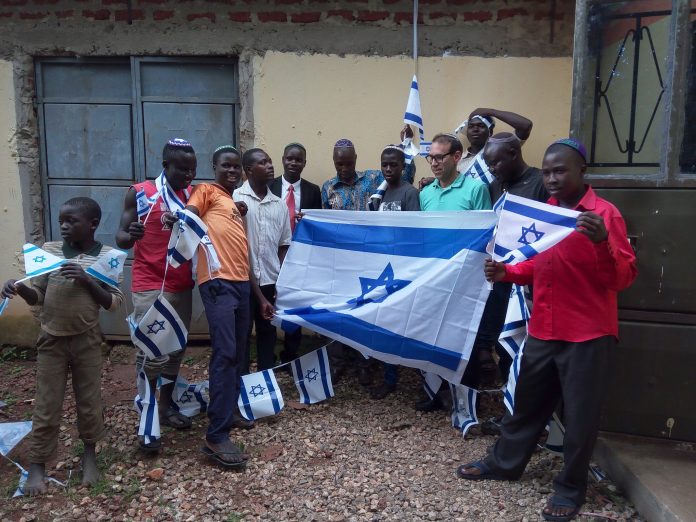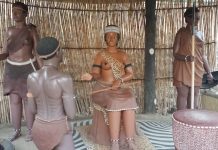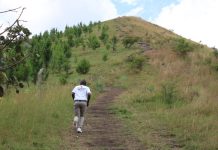The Abayudaya community is found in the outskirts of Mbale at Nabugoye Hill which emerges as the sacred site of the Moses Synagogue, a spiritual home for a small and secluded community of Ugandan Jews. While the Abayudaya have yet to receive formal acceptance as Jews, there is a growing anticipation that this might change in the years to come, pending an official conversion recognized by a court of Rabbis.
Regardless of official recognition, the Abayudaya seriously adhere to Jewish customs and rituals, observing the same holidays as their Jewish counterparts worldwide. Their Sabbath services unfold on Friday evenings and Saturday mornings, and they rigorously maintain kosher practices in alignment with Talmudic law. Although they abstain from partaking in local Bamasaba circumcision rituals, choosing instead to circumcise males eight days after birth, their commitment to Jewish traditions remains firm.
Marriage outside the community brings about a transformation in status for the Abayudaya. Those who marry non-community members are no longer considered Abayudaya unless their spouses willingly embark on the journey of conversion. This interplay of tradition, faith, and community dynamics creates a unique shade which reflects the Abayudaya’s dedication to their Jewish identity in Uganda. As the future unfolds, the Abayudaya’s journey towards official recognition promises to be a significant chapter in the narrative of global Jewry.
History of the Abayudaya community
In the late 19th century, the term “Abayudaya” found its origins in the Luganda language. Missionaries of the time created this term in an attempt to distinguish the exotic religion they were introducing from European influences, drawing a connection to the people of Judea instead. However, this strategic move took an unexpected turn when the first Luganda translation of the Bible was unveiled.
Literate Muganda individuals began to question the missionaries as to why their local tradition of polygamy faced condemnation when many of the Abayudaya portrayed in the Old Testament proudly embraced having more than one wife.
Among the notable religious objectors in Uganda during the early 20th century was Malaki Musajakawa, a charismatic figure who led the Malakites, an Africanist Christian sect. At its peak, the Malakites successfully attracted a substantial following, with estimates suggesting up to 100,000 Ugandans persuaded from more conventional denominations.
The Malakite doctrine, rooted in a selective interpretation of Old Testament verses, took firm posture against the consumption of pork, the use of any form of medicine, and proudly supported polygamy. Unsurprisingly, these unconventional beliefs did not sit well with British colonists, leading to increased tensions between the authorities and the sect.
The turning point occurred in 1926 when a plague swept through Uganda. The Malakites boldly protested the use of vaccination to combat the disease which resulted in a violent clash with the authorities. In the aftermath, Malaki Musajakawa faced imprisonment and eventual exile to northern Uganda. His life concluded tragically after a prolonged hunger strike, marking the end of the Malakite sect as it gradually disbanded.
A pivotal figure in the dissemination of Malakitism across eastern Uganda was Semei Kakungulu. Disappointed with the colonial authorities after retiring from the presidency of Busoga in 1913, Kakungulu embraced the anti-establishmentarian belief of the expanding faith. Shifting away from politics, he dedicated his focus to spiritual matters, immersing himself in the Bible and other Christian tracts.
Inevitably, Kakungulu began to formulate his own interpretations of Malakite doctrines, leading to a split within the Mbale Malakites. The primary point of contention centered on male circumcision. Kakungulu and his followers, aligning with Old Testament teachings, considered circumcision integral.On the contrary, a majority of Malakites viewed it as desecration.
The dispute, rooted in Kiganda tradition, forbade any form of bodily mutilation. However, Malakite objections to circumcision were rationalized by attributing it to the practices of the Abayudaya people, who were portrayed as non-believers in Jesus Christ.

The foundation of the present-day Abayudaya community can be traced back to 1920 when Semei Kakungulu, disappointed by the internal conflict within the Malakite sect, declared a complete separation. Frustrated with the infighting, Kakungulu chose to align himself with those willing to undergo circumcision, proclaiming them as “the Jews.” At the age of 50, Kakungulu underwent circumcision alongside his firstborn son, initiating a tradition of circumcising his subsequent sons eight days after birth and giving them Old Testament names.
In 1922, Kakungulu published a distinctive Luganda religious text deeply influenced by Jewish principles. This text emphasized unwavering faith in the Old Testament and its commandments, marking a defining moment for Kakungulu and his followers.
However, Kakungulu’s version of Judaism during this period was a blend of Jewish and Christian customs. Having never encountered genuine Jews and lacking knowledge of authentic Jewish practices, the Abayudaya referred to their place of worship not as a synagogue but as a “Jewish church.” Remarkably, they accorded equal significance to Christian baptism and the act of circumcision.
This practice persisted until 1926, when Kakungulu, under the apprenticeship of Yusuf, a Jewish settler, underwent a transformative six-month instructional period. Guided by Yusuf, Kakungulu revised his religious text, removing Christian prayers. He directed his followers to abandon the baptism of children, observe the Saturday Sabbath, and adhere to Jewish dietary customs, signifying the community’s formal conversion to Judaism. This pivotal moment marked the Abayudaya’s commitment to embracing a more authentic Jewish identity under the guidance of Yusuf.
Remaining true to his iconoclastic nature, Semei Kakungulu upheld a particular Malakite doctrine that sharply contrasted with modern Judaism: the outright rejection of medicine. This idiosyncratic stand, symbolized by Kakungulu’s unwavering convictions, persisted even in the face of a critical health challenge. On November 24, 1928, Semei Kakungulu suffered from pneumonia and refused any medical intervention that could potentially have saved his life.
However, after Kakungulu’s death, the Abayudaya community intentionally distanced themselves from their neighbors, embracing a lifestyle devoid of materialistic values. They are easily identied in a crowd by their distinctive attire of animal hides and barkcloth.
During the early years, the Abayudaya faced mild persecution, particularly from neighboring Christian communities that held prejudiced views against Jews. Despite such challenges, the community flourished until 1971 when Idi Amin, the then ruler, imposed a ban on Judaism. Amin ordered the closure of 32 synagogues and mandated the Abayudaya to convert to either Christianity or Islam. In the face of this oppressive regime, approximately 3000 Abayudaya renounced their faith to escape the threat of beatings or torture by the military.
The Amin era marked a dark period for the Abayudaya community, with some members facing brutal consequences for their commitment to their beliefs. Despite these hardships, a few hundred practicing Abayudaya persisted by the end of Amin’s rule. Since then, the community has enjoyed the freedom to practice their faith without persecution, with their numbers growing to around 2000 individuals. The Jewish converts stay at Nabugoye hill, also known as Galilaya which belonged to their founder, Semei Kakungulu
Additional communities and synagogues have emerged in Namanyonyi, Pallisa, and Namatumba. Although debates within the broader Jewish community persist about the full acceptance of Abayudaya, significant strides toward integration have occurred under the leadership of Gershom Sizomu, the Chief Rabbi of Uganda.
Music to the Abayudaya community

Under Kakungulu’s guidance, the Abayudaya community developed a distinctive style of spiritual music, blending the text of recognized Jewish prayers with African melodies and rhythms. This musical tradition, captured on CDs, reflects the resilience and revival of a community that has weathered historical challenges to sustain its unique identity and faith.
One remarkable album, titled “Abayudaya,” stands out as a testament to the community’s musical prowess. Produced by Jeffrey Summit, this masterpiece earned a Grammy nomination for the Best Traditional World Music Album at the 47th Grammy Awards in Los Angeles on February 3, 2005. This recognition catapulted the Abayudaya onto the global stage, acknowledging their unique blend of traditional African and Jewish musical expressions.
The Abayudaya community has continued to thrive as Noam Katz, a Jewish American musician has played a pivotal role in elevating the Abayudaya’s musical journey. He features them in several of his songs, Katz has been a catalyst for further acclaim and respect for the community. The distinctive nature of Abayudaya music lies in its fusion of Luganda and Hebrew, creating a harmonious blend of African and Jewish linguistic and musical traditions.
In their psalms and prayers, the Abayudaya infuse a distinctly African tune and rhythm, adding a rich layer to their spiritual expressions. The interplay of languages and melodies reflects the cultural duality that defines the Abayudaya musical experience.
For the elders of the Abayudaya community, they believe music holds a profound significance. It has been a source of resilience, enabling them to navigate through challenging periods, particularly during the tumultuous reign of Idi Amin. As the Abayudaya continue to craft melodies that echo their faith and heritage, their music stands not only as a testament to their journey but also as a bridge connecting diverse traditions in a harmonious symphony.
Nabugoye synagogue and Kakungulus grave
Located 4 km east of Mbale city, Nabugoye Hill stands as the spiritual home for the Abayudaya, an isolated Jewish community founded in 1920 under the leadership of the Musoga politician Semei Kakungulu. At the top of this community lies the Moses Synagogue that was built on a flat site and surrounded by other small structures. The synagogue was constructed in buff colored stucco at the front facade yet exposed on the sides and rear of the building. It has a corrugated metal gabled roof that is set on simple wood framing with ten glass window units with metal security grilles. Other synagogues have opening walls and two single and one pair of painted wood paneled doors. Above the doors it has perforated bricks that act as vents. The front side of the synagogue is hand painted with the name of the community and two menorot which give a clear indication that it is an Abayudaya Jewish house of prayer. The optimal time to visit Nabugoye, especially for an overnight stay, is during the weekly Shabbat. They start on Friday night and extend into Saturday morning, the Shabbat culminates in the Torah reading by Rabbi Gershom Sizomu. Notably, Rabbi Gershom Sizomu holds the distinction of being the first indigenous Black African rabbi, having received ordination in the USA in 2008.
The Nabugoye Synagogue has evolved into a pilgrimage site, attracting curious visitors from Israel and other parts of the world. Despite its Jewish roots, the synagogue warmly welcomes individuals of diverse religious backgrounds. Rabbi Gershom Sizomu, proficient in English, ensures that all visitors feel included. There is no entry fee but donations can be offered. Visitors are advised that photography in all forms is prohibited between Friday sunset and Saturday.
A brief 10-minute walk to the east of the synagogue leads to the covered grave of Semei Kakungulu. Marked with a Star of David and three spears, this resting place is adjacent to those of Kakungulu’s brother and daughter.













